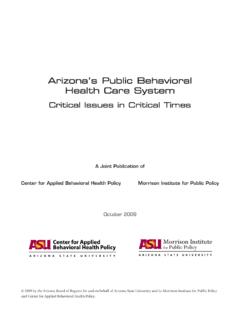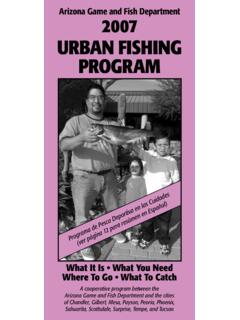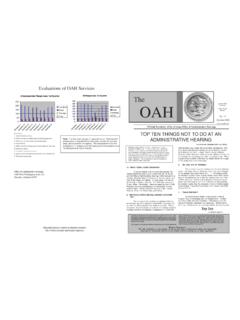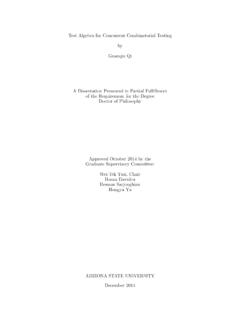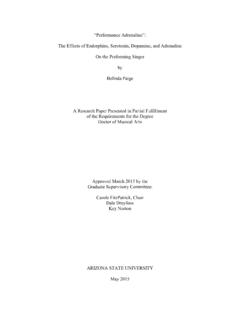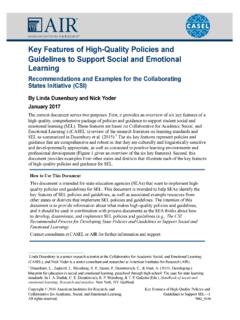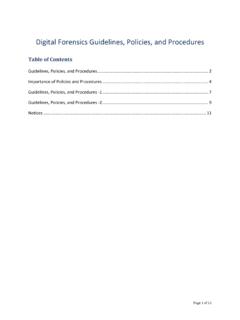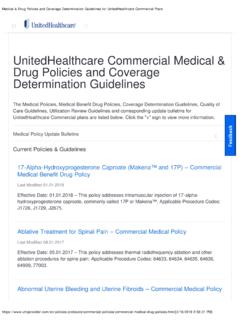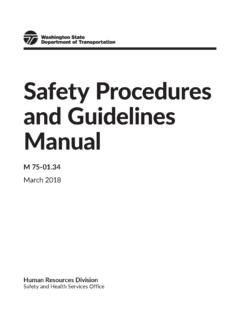Transcription of PEDESTRIAN POLICIES AND DESIGN GUIDELINES
1 Maricopa Association of GovernmentsPEDESTRIAN POLICIESAND DESIGN GUIDELINES2005 Maricopa Association of GovernmentsPedestrian POLICIES and DESIGN GuidelinesMaricopa Association of GovernmentsMARICOPA ASSOCIATION OFGOVERNMENTSP edestrian POLICIES andDesign GuidelinesApril 2005 Maricopa Association of GovernmentsMaricopa Association of GovernmentsPedestrian POLICIES and DESIGN GuidelinesMARICOPA ASSOCIATION OFGOVERNMENTS REGIONALCOUNCILM ayor Keno Hawker, City of Mesa, ChairMayor J. Woodfin Thomas, City of Litchfield Park, Vice ChairMayor Douglas Coleman, City of Apache JunctionJoe Lane, Arizona Department of TransportationDallas Rusty Gant, Arizona Department of TransportationMayor Ron Drake, City of AvondaleMayor Dusty Hull, Town of BuckeyeMayor Edward C. Morgan, Town of CarefreeMayor Vincent Francia, Town of Cave CreekMayor Boyd Dunn, City of ChandlerRoc Arnett, Citizens Transportation Oversight CommitteeMayor Fred Waterman, City of El MiragePresident Raphael Bear, Fort McDowell Yavapai NationMayor Wally Nichols, Town of Fountain HillsMayor Christopher Riggs, Town of Gila BendGovernor Richard P.
2 Narcia, Gila River Indian CommunityMayor Steven Berman, Town of GilbertMayor Elaine Scruggs, City of GlendaleMayor James M. Cavanaugh, City of GoodyearMayor Frank Vacaneri, Town of GuadalupeSupervisor Don Stapley, Maricopa CountyMayor Ronald B. Clarke, Town of Paradise ValleyMayor John Keegan, City of PeoriaMayor Phil Gordon, City of PhoenixMayor Wendy Feldman-Kerr, Town of Queen CreekPresident Joni Ramos, Salt River Pima-Maricopa IndianCommunityMayor Mary Manross, City of ScottsdaleMayor Joan Shafer, City of SurpriseMayor Hugh Hallman, City of TempeMayor Adolfo Gamez, City of TollesonMayor Ron Badowski, Town of WickenburgMayor Bryan Hackbarth, Town of YoungtownMANAGEMENT COMMITTEEMike Hutchinson, City of Mesa, ChairEd Beasley, City of Glendale, Vice ChairGeorge Hoffman, City of Apache JunctionVictor Mendez, Arizona Department of TransportationCharlie McClendon, City of AvondaleCarroll Reynolds, Town of BuckeyeJon Pearson, Town of CarefreeUsama Abujbarah, Town of Cave CreekMark Pentz, City of Cornwall, City of El MirageTim Pickering, Town of Fountain HillsLynn Farmer, Town of Gila BendUrban Giff, Gila River Indian CommunityGeorge Pettit, Town of GilbertStephen Cleveland.
3 City of GoodyearMark Johnson, Town of GuadalupeDarryl Crossman, City of Litchfield ParkDavid Smith, Maricopa CountyTom Martinsen, Town of Paradise ValleyTerry Ellis, City of PeoriaFrank Fairbanks, City of PhoenixCynthia Seelhammer, Town of Queen CreekJan Dolan, City of ScottsdaleJim Rumpeltes, City of SurpriseWill Manley, City of TempeRalph Velez, City of TollesonShane Dille, Town of WickenburgDavid Boggs, Valley Metro/RPTAMark Fooks, Town of YoungtownPEDESTRIAN WORKING GROUPTami Ryall, Town of Gilbert, ChairCharlie McClendon, City of Avondale (past Chair)Bruce Meyers, Arizona Department of AdministrationAnna Roedler, City of AvondaleMichael Eagan, ASLABill Lazenby, Coalition of Arizona BicyclistsMichael Ohland, City of ChandlerMichael Normand, City of ChandlerSteve Hancock, City of GlendaleJaneen Gaskin, City of GoodyearMike Cartsonis, City of Litchfield ParkScott Lininger, Maricopa CountyPeggy Rubach, Maricopa CountyMark Venti, City of MesaKaren Flores, City of PeoriaTim Bolton, City of PeoriaShawny Ekadis, Town of Queen CreekBriiana Leon, City of PhoenixKatherine Coles, City of PhoenixDawn Coomer, City of ScottsdaleReed Kempton, City of ScottsdaleEric Iwersen, City of TempeRandi Alcott, Valley MetroMARICOPA ASSOCIATION OFGOVERNMENTS STAFFD ennis Smith, Executive DirectorEric Anderson, Transportation DirectorMaureen DeCindis.
4 Transportation PlannerACKNOWLEDGEMENTSM aricopa Association of GovernmentsPedestrian POLICIES and DESIGN GuidelinesiPedestrian POLICIES and DESIGN GuidelinesMaricopa Association of GovernmentsTTTTTABLEABLEABLEABLEABLE OFOFOFOFOF C C C C Purpose of the Are the Benefits of This Should Use This This Document is in This Updated Brief History of PEDESTRIAN Planning in the PRINCIPLES OF PEDESTRIANS AND THEIR FOR and of of PEDESTRIAN FACILITY Making DESIGN Facility Facility Facility and Conduct a PEDESTRIAN Review Zoning Review Check Safe Route To School and Conducting A Safe Route toSchool Routes to School Sponsor a Training Set Up a Speakers OF POLICIES and DESIGN GuidelinesMaricopa Association of Governments1 PEDESTRIAN POLICIES and DESIGN GuidelinesMaricopa Association of GovernmentsINTRODUCTIONP edestrians are an integral part of any transportationsystem.
5 Any driver becomes a PEDESTRIAN themoment he or she leaves a vehicle or transportation users are pedestrians whenthey walk to the public transit stop and againwhen they walk to their destination. If the entiretransportation system is to function efficiently,we must plan for the needs and expectations ofpeople who walk. This publication is intendedto make the places we walk safer, more comfortable,and more desirable as to Mean Streets 2004, a SurfaceTransportation Policy Project, the city of Phoenixhas the tenth highest PEDESTRIAN danger index(PDI), The PDI compares the annualrate of PEDESTRIAN deaths relative to the numberof people who walk in a community. This highscore is attributed to sprawling, low-densitydevelopment connected by high speed , this number is down 12 percent fromthe 1994-1995 PDI. The 2004 report statesthat 4,827 people died in 2003 while walkingdown the street, down from 4,919 in 2002.
6 Ineach of these same two years, there were 70,000injuries. In Arizona, there were 156 fatalitiesin 2002, and 125 in 2003, an average annualrate per 100,000 residents of , spending on PEDESTRIAN projects is notcommensurate with the apparent need. SaysMean Streets 2004, Nationally, less than onepercent of federal transportation funds have sofar been spent on PEDESTRIAN facilities .BACKGROUNDThe Maricopa Association of Governments (MAG)Regional Council formed the PEDESTRIAN WorkingGroup in 1993 to educate the region aboutpedestrian issues, and to promote the developmentof facilities for people to walk. The Working Groupconsists of MAG members, and representativesof the planning, architecture, landscape architecture,and development PEDESTRIAN gathering POLICIES and DESIGN Guidelines2In 1993, in order to discover what the needsand expectations of pedestrians were in this region,the MAG PEDESTRIAN Working Group analyzed15 local sites with varying degrees of pedestrianaccommodations.
7 The data identified potentialorigins and destinations for pedestrians, theperceptions of personal safety and security heldby people who walk, reasons for walking, pedestriancounts, long range plans for the area, physicalmeasurements, and other PEDESTRIAN MAG PEDESTRIAN Area POLICIES and DesignGuidelines were the result of this effort in the document was completed, Valley plannersand designers have had a chance to read anduse the document and put the GUIDELINES intopractice. Additionally, there are new studies inseveral areas of PEDESTRIAN activity, including SafeRoutes to School, elderly mobility, and changesin the Americans with Disabilities Act AccessibilityGuidelines (ADAAG). This update of the Policiesand GUIDELINES incorporates this new data andcreates a more user-friendly PURPOSE OF THEGUIDELINESThe PEDESTRIAN Area POLICIES and DESIGN Guidelinesare intended to provide a source of informationand DESIGN assistance to support walking as analternative transportation mode.
8 Throughapplication of the POLICIES and DESIGN guidancein this document, jurisdictions, neighborhoods,land planners, and other entities will be able to:1) better recognize opportunities to enhance thebuilt environment for pedestrians; 2) better createand redevelop PEDESTRIAN areas throughout theregion that integrate facilities for walking withother transportation modes; 3) support thedevelopment of areas where walking is the preferredtransportation mode; and 4) encourage thedevelopment of other independent PEDESTRIAN -focused transportation POLICIES and specific DESIGN GUIDELINES in thisdocument accomplish this intent by providingpolicy and DESIGN guidance to make all pedestrianareas and facilities safe, comfortable, and adestination for people who use them. Each ofthese purposes is described grand announcement to a PEDESTRIAN area. a sidewalk a path or trail a crosswalk/mid-block crossing a traffic calming feature an under and overpasse/grade separation a wide shoulder other elements that encourage pedestrianmovement, such as landscaping, public art,and site furnitureWhat is a PEDESTRIAN Facility?
9 3 PEDESTRIAN POLICIES and DESIGN GuidelinesMaricopa Association of GovernmentsSafetyFirst and foremost, a transportation facility mustbe safe. This update includes recommendationsand GUIDELINES directed toward making all pedestrianfacilities safesafesafesafesafe for users of all abilities. Theseminimum levels of safety that should be met inall circumstances include: providing a definedwalkway for exclusive PEDESTRIAN use that is aminimum 6-feet wide; a walkable surface thatis clear of impediments; has ramps where needed;is physically or horizontally separated from vehiculartraffic; and is lit at roadway crossings. Thereare several elements of DESIGN , in particular ramps,driveway crossings, and median crossings that,if the project is new, should be built to the standardsof the comfortable level to meet safety, there are DESIGN options and amenitiesthat can make a PEDESTRIAN area comfortablecomfortablecomfortablecomfort ablecomfortableand encourage more walking.
10 These include:wider walkways (7 to 12 feet or more); two orthree options for physically or horizontally separatingthe walkway from traffic; reducing the numberof driveway crossings; providing places to sit;or adding traffic calming , PEDESTRIAN areas that are safe and comfortablecan be made destinationsdestinationsdestinationsdest inationsdestinations unto themselves,to which people walk to and walk within. Destinationsare places where walking is considered apredominant, if not the only, mode of often have extensive amenities which includespecialty paving, themed signs and site furnishings,decorative lighting fixtures, street vendors, andan active GUIDELINES additionally incorporate the principleof universal DESIGN . Universal DESIGN is a philosophyof facility DESIGN that seeks to maximize the suitabilityof a facility for ease of use by the greatest numberof people. It emphasizes the value of designingfacilities for a person s entire lifespan and rangeof abilities.


